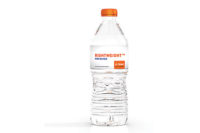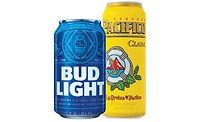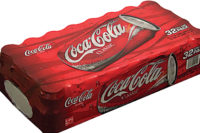Plastic packages influenced by lightweighting, bio-based materials
Consumers desire for convenience and health and wellness objectives driving innovations

Amcor Rigid Plastics North America released Powerblock 3.0, a 64-ounce hot-fill PET bottle that weighs 59 grams — 9 grams less than a typical PET bottle, the company says. (Image courtesy of Amcor Rigid Plastics North America)



Although the plastic bottle market in the United States serves a number of different industries and manufacturers, the beverage business continues to play a large role. According to Santa Monica, Calif.-based IBISWorld’s January 2013 report “Plastic Bottle Manufacturing in the US,” beverage bottles made up 45.5 percent of its total $12.4 billion in sales among the major market segmentations in 2012.
However, due to changes in consumer tastes and reduced spending, revenue in the carbonated soft drink production industry has declined since 2007, the market research firm’s report states. “This decline has led to weakened demand for the plastic bottles in which soft drinks are packaged,” according to the report. “In 2010, downstream markets began their recovery from the recession, and as a result, revenue for the plastic bottle manufacturing industry is expected to rise 2.4 percent in 2012.”
IBISWorld also is anticipating that demand from beverage manufacturers for plastic will increase slowly during 2013.
Changing consumers
Although suppliers of plastic resins are working with beverage manufacturers for end product packaging, staying in tune with what consumers are looking for can help them serve the beverage marketplace as well.
“Consumers are very aware of the products they drink and the packaging that the product comes in,” says Michael Hodges, vice president of marketing for the beverage business unit of Amcor Rigid Plastics North America, Ann Arbor, Mich. “Consumers are looking for a bottle that lives up to their standards. Is it good for the environment? Is it good for the product I’m drinking? Is it good for me?”
Another trend Hodges is seeing is consumers’ need for convenient packages to fit their on-the-go lifestyles. “Consumers have busy lifestyles, so convenience means many things — convenience [in] that it is easy to pick up and go, convenience [in] that it doesn’t spill, convenience [in] that it is the right size, and convenience [in] that I can find it where and when I want it,” he says.
Ron Puvak, director of business development and marketing for Plastic Technologies Inc., Holland, Ohio, also notes the benefits that plastic packaging can offer for consumers’ lifestyles. “Plastic packaging supports the consumer’s need for on-the-go, convenience-oriented packaging,” he says. “It is lightweight and can be formed into the desired volumes for portion control, which appeal to those with healthy lifestyle objectives.”
Health and wellness objectives and changes in consumers’ beverage choices also are something plastic resin suppliers are noticing. “Consumers continue to trend toward bottled water, nutritional beverages, energy drinks and teas, which is driving growth for [polyethylene terephthalate] (PET) packaging,” says John Cullen, director of resin sales and marketing for DAK Americas, Charlotte, N.C. “Since these beverages are more likely to be sized for individual servings, the number of bottles grows as the 2-liter package is displaced. The sparkling beverage segment continues to see modest reductions in demand as consumers explore the expanding selection of alternative drinks.”
Cullen also notes that the most important factor when opting to package a beverage in PET is consumer preference. “PET offers a lightweight, durable, resealable container with the visual appeal that drives consumer preferences,” he says.
This attraction also has led to non-beverage brands choosing to introduce their products in PET packaging, he adds.
Sustaining the future
But consumer awareness is just one of many areas that plastic resin suppliers are in tune with; they also are trying to meet their customers’ needs when it comes to sustainable alternatives.
“Sustainability is an important concept for plastic bottles and many other materials and products that consume vital resources and energy in their production and distribution,” Cullen says. “By the nature of its indefinite recyclability, PET can be reused many times with no additional raw material consumption and reduced energy requirements. With the advent of bio-based raw materials, like monoethylene glycol made from plant-based materials, PET can be produced with reduced consumption of fossil fuels from a renewable resource.”
Rich Chapman, vice president of supply chain at Chicago-based Berlin Packaging, notes that the company continues to receive a lot of requests for post-consumer-recycled (PCR) products, bio-based resins as well as reduced gram weight in bottles and closures.
Plastic Technologies’ Puvak notes that one thing resin suppliers should keep in mind while developing more bio-based products is that they do not negatively impact current recovery and recycling streams.
In addition to bio-based materials, suppliers are looking at numerous ways to address sustainability trends.
“Sustainability is the overarching theme; people want sustainable packaging, and there’s lots of different ways for us to address that,” Amcor’s Hodges says. “If you go back and look at sustainability at the very core, the most important thing that you can do is ensure the product is protected. If there’s any waste, any spillage, any degradation of the product, [then] you’ve lost all sustainability efforts.”
Hodges notes that when it comes to plastic bottles, it is important to develop the optimal weight to protect the product inside. “If we lose any product on the way to the store shelf or on the way to the consumer’s hands, then it’s not a sustainable package. We continue to look for the optimal product weight for product protection and then live within those sustainable guidelines,” he says.
Amcor’s latest development to meet these guidelines is the Powerblock 3.0 PET Bottle, a 64-ounce hot-fill PET bottle that weighs 59 grams — 9 grams less than a similar-sized PET bottle, the company says.
“Our talented engineers reduced the finish from 43 mm to 38 mm and then took [out] additional gram weight throughout the body, which was made possible by a new patented base design,” Hodges explains. “This base technology provides the ability to pull weight out of the base and distribute it much more efficiently throughout the entire sidewall of the bottle.”
Although the reduction of material has benefited the environment and overall packaging cost for our customers, lightweighting should not affect branding and package design, Hodges adds.
“Lightweighting has definitely impacted bottle weights, but it can’t detract from the brand image of the package,” he says. “Our customers want to brand their package in a way that’s going to make it jump off the store shelf.”
Resin suppliers also are investing in the development of recycled content to offer affordable and sustainable solutions. Phoenix Technologies, a sister company of Plastic Technologies and producer of recycled PET (rPET), launched LNO w resin, a new food-grade, melt-extruded rPET pellet.
The new rPET product targets both blow-molded and thermoformed applications for water and cold-filled beverages. LNO w resin is ideal for packages that aren’t subjected to heat either in the filling process or during consumer usage, the company says. It can be used at levels up to 100 percent or blended with virgin PET, it adds.
“As you expand your conditions of use, the decontamination process gets more rigorous,” said Lori Carson, director of commercial operations for Phoenix Technologies, in a statement. “These cold-filled, frozen or ambient-use applications do not involve a thermal process. That means they can use a resin that has been produced under milder processing conditions. LNO w resin combines ideal properties with desirable cost attributes for these applications.”
Plastic Technologies’ Puvak notes that although PET is the most popular choice in the beverage industry due to its versatility, excellent barrier properties, and high level of performance at lighter weights, there are many viable options for beverage-makers.
“RPET is used in varying percentages — typically around 25 percent — along with virgin PET, depending on performance and environmental objectives,” he says. “However, rPET can comprise as much as 100 percent of the bottle.
“[Polypropylene] (PP) and [high-density polyethylene] (HDPE) materials are used for many juice and some specialty beverage applications,” Puvak continues. “HDPE has been the material of choice for many years in dairy applications. Large-capacity HDPE containers have become the standard in some market segments. We do see new grades of extrusion-blow-molded PET, which have recently entered the market and are expected to challenge some applications, which have typically been in HDPE and PP.”
But beyond all the efforts of resin suppliers to make plastic bottles more sustainable, experts also note the importance of recycling rates for plastic containers.
“PET container recycling has grown to more than 28 percent annually in the U.S.,” Puvak says. “In fact, in the U.S., PET water bottles have achieved a recycling rate of 39 percent, per a recent [National Association for PET Container Resources] (NAPCOR) report. Recycling rates are much higher in other parts of the world. These trends make the public perception of plastic bottles more favorable.”
DAK Americas’ Cullen notes that although PET and plastic bottles, in general, are popular with consumers, the biggest challenge is improving retrieval and handling of the bottles after use.
“Nothing hurts the perception of plastic more than the image of bottles littering the environment on which we all depend,” he says. “Beverage companies along with their suppliers, communities, local governments and non-government entities are all working to improve the recycling rate. In addition, efforts are under way to educate consumers on the value of recycling and of minimizing disposal to landfills.”
But no matter what new develop-ments, ecological or otherwise, resin suppliers are releasing, the future remains positive for plastic bottles and the beverage market.
“Within the next several years, we will see significant progress in bio-derived or -based [resins],” Plastic Technologies’ Puvak says. “We will also see more lifestyle-conscious products entering the market. These and other factors position plastic to be the packaging of choice for beverages.”
Looking for a reprint of this article?
From high-res PDFs to custom plaques, order your copy today!









